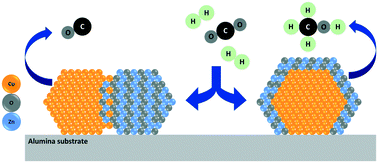Copper–zinc oxide interface as a methanol-selective structure in Cu–ZnO catalyst during catalytic hydrogenation of carbon dioxide to methanol†
Abstract
Detailed structural and catalytic studies of ZnO/Cu/Al2O3 catalysts, aimed at deriving a better understanding of the methanol selectivity–structure relationship in the Cu–ZnO system for catalytic hydrogenation of carbon dioxide, have been conducted. Two different synthesis methods were employed, preferential chemical vapor deposition and incipient-wetness impregnation, to generate two different ZnO/Cu morphologies, which result in significantly different methanol productivity and selectivity. The incipient-wetness impregnation method results in a very high dispersion of zinc oxide over both the copper and alumina support and the subsequent formation of smaller copper particles. Preferential chemical vapor deposition deposits zinc oxide directly onto the pre-formed copper phase and yields more developed and ordered zinc oxide and copper phases. The combination of catalytic and structural (X-ray spectroscopy, X-ray diffraction, and electron microscopy) studies indicates that preferential chemical vapor deposition results in a more favorable habit of the zinc oxide in relation to the copper, which leads to more extensive formation of the ZnO–Cu interfaces required to promote the selective reduction of carbon dioxide to methanol. On the other hand, the very high dispersion of zinc oxide and copper in the impregnated sample leads to a less favorable intimacy of contact between the Cu–ZnO phases and results in a higher activity for the reverse water–gas-shift reaction, greater carbon monoxide production, and to decreased activity and selectivity for methanol production. These results, therefore, indicate that the proper contact of zinc oxide and copper phases is an essential consideration for achieving high activity and selectivity toward methanol in the Cu–ZnO system, and one that outweighs the dispersion of the reduced copper phase.



 Please wait while we load your content...
Please wait while we load your content...